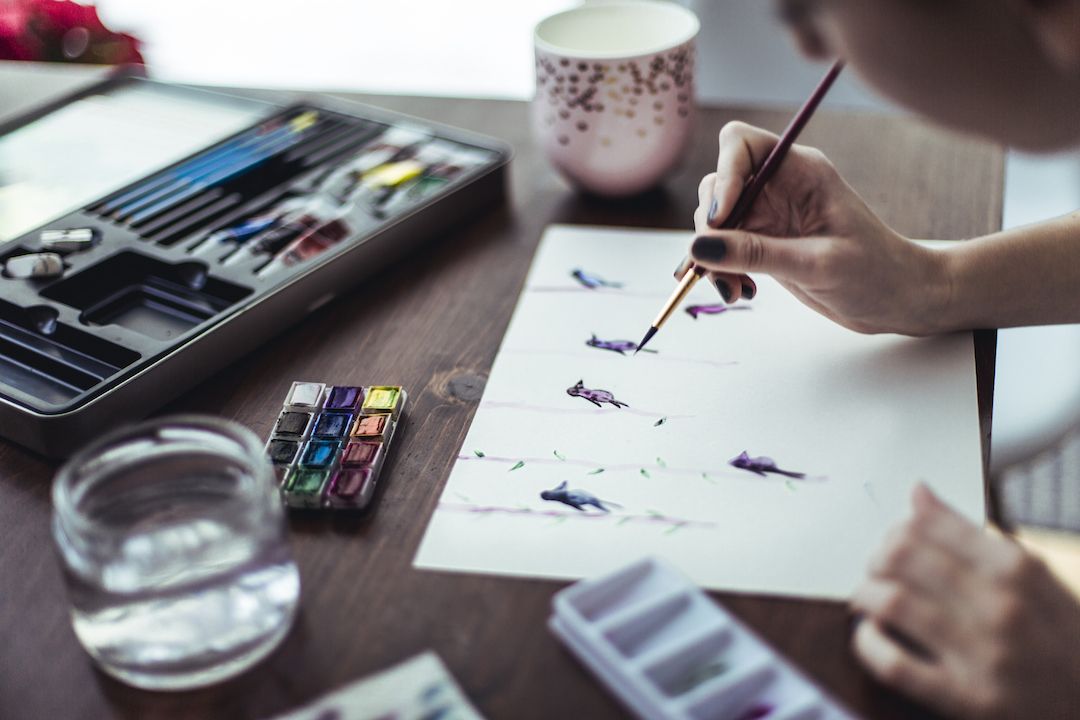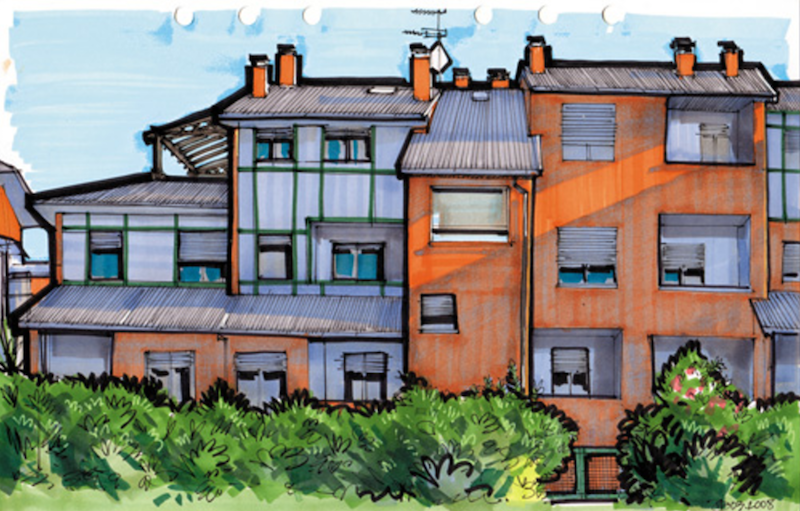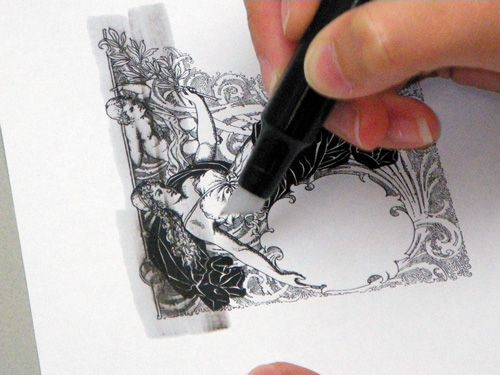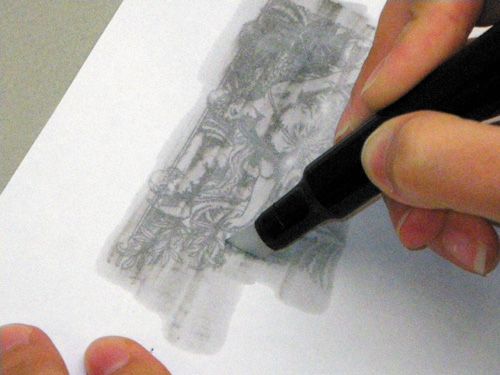How To Draw With Micron Pens

Learn to Draw with Markers and Ink like a Pro
Drawing with markers offers most instant gratification—markers are elementary to use, require petty prep time and dry quickly. Because the marking textile is fluid, the smooth marks are different those made past dry drawing mediums.
Drawing with markers will offer you a range of brilliant color that surely will excite your creativity. They're ideal for creating loose lines, calligraphic designs and precise technical illustrations.
One drawback to using them is that information technology's not easy to right mistakes. To piece of work successfully, you need a fleck of confidence and some cartoon feel.
The many different types of markers go past diverse names, such as fine art markers, mark pens, creative person pens, brush pens and paint markers. Art pens and markers come in every colour y'all can imagine and tin be purchased in sets to save coin. They vary in size and tip shape and are further distinguished past their colorant, which can be dye, ink or paint, and alcohol-, water- or solvent-based.

Different Types of Markers
When learning how to draw with markers, it'due south important to consider the unlike types. 3 common kinds of markers are listed below: alcohol-based, water-based and solvent-based. Knowing the different qualities of each will aid you choose which markers are best for your drawing needs.
Alcohol-Based
These markers are fast-drying and waterproof. They don't olfactory property as potent as solvent-based brands, simply they tin can still cause middle or respiratory irritation. Brand certain your workspace is well ventilated.
Considering booze-based markers dry rapidly, the paper you work on doesn't stay moisture and is less probable to be torn every bit you layer colors. Pop brands among artists and designers include Prismacolor, Letraset Tria and Copic, whose pens are refillable. Sharpies, the all-purpose permanent markers, are also alcohol-based.
 Water-Based
Water-Based
Considering they are odorless and safe to employ, h2o-based markers are the best selection for children. But adults can obviously make good use of them, as well.
Some have castor tips fabricated of foam or dense fiber. Others are chisel-shaped or have nylon brush tips that distribute the colour.
Water-based paint markers, such as Sakura Permapaque markers, are opaque, generally quick-drying and water-resistant when dry.
Near castor pens and markers are water-based and accept flexible nylon or cream tips shaped like traditional brushes. They brand marks like to modest round bristle brushes and have a similar experience in the manus.
Many brush markers are double-ended, with a fine point on one finish and a wider tip on the other. Brush pens and markers often use acid-free ink, which is ideal for calligraphic work, fine art journals and book arts. Try Staedtler Marsgraphic 3000 Duo, Pitt Creative person Pens, Pentel Brush Pens or Marvy Castor Markers.
Solvent-Based
This type of marker creates brilliant color and is waterproof and long-lasting. A popular solvent-based brand for design and drawing is Chartpak Ad markers, whose solvent is xylene.
The solvents in markers can be xylene, methyl isobutyl ketone or butyl acetate, all of which tin cause dizziness, headaches and nausea. Markers with these solvents should be used only in studios with excellent ventilation. Solvent-based markers aren't suitable for children.
Many pigment markers are solvent-based and opaque. You tin employ pigment markers on porous and nonporous surfaces. They're generally waterproof, merely not necessarily permanent.
Pigment markers are most useful for arts and crafts or decorative projects and signage. Shake them to mix the paint inside, and ensure your workspace has proper ventilation. This marking type, which come in many colors including metallics, can be blended with Turpenoid or other solvents.
Using Dip Pens

Long earlier markers hit fine art store shelves, artists drew with pen and ink. Dip pens have been fabricated from reeds or quills since ancient times. The simplest is a Japanese hand-carved bamboo pen that has its shaft shaped into a tip that can exist dipped into a pot of ink.
A bit more refined is a pen with an interchangeable metal nib held in a simple wooden or plastic handle. Drawing nibs are pointed metallic tips that are somewhat flexible and so the lines produced are thicker or thinner depending on the pressure of the mitt.
Like nibs are also available in pens that concur a reservoir of ink within the handle, like a fountain pen, obviating the demand to dip the pen into a pot of ink. The reservoir can be a disposable or refillable cartridge.

Mechanical pens take a metal, needle-like tip instead of a neb and produce a controlled line of predetermined width from 0.thirteen to 1.iv millimeters. Mechanical pens can be used for precise drafting and technical piece of work or for sketching, although the unchanging width can become monotonous.
Black India ink is pigment-based ink that is permanent, lightfast and waterproof. Colored inks are acrylic- or shellac-based and tin be thinned with water. Some colored inks aren't lightfast and shouldn't be exposed to direct sunlight for long periods.
3 Piece of cake Ways to Improve Your Drawings
At present that we have covered the basics, here are 3 like shooting fish in a barrel tips for drawing with markers and ink.
- Line and wash: First do a line drawing in pen or ink. When it'southward dry, add lite washes with markers, watercolor or castor and ink. If the initial drawing is done in water-soluble ink, the wash will soften the ink lines, creating an interesting fusion of line and tone.
- Layering: Markers lend themselves perfectly to blending and layering color. Offset with the lightest colors, building upward rich layers of color and texture. Colorless blenders, such as those from Prismacolor and Chartpak, can be used to soften edges and combine colors.
- Combining media: Watercolor brush markers can be blended and lightened with a brush dipped in h2o or can exist used in combination with traditional watercolor
techniques.
Try Transferring an Epitome
Another great drawing technique is to utilize solvent-based colorless blenders to transfer laser-printed images to paper. Run a wide tip colorless blender over the area of the epitome yous want to transfer.

Flip the paper over onto the surface you want to marker, and run the blender over the prototype area on the back side.

The printed prototype, to which you can add colour, volition appear in reverse on the surface.

Learn more image transfer tips here.
Sign upwardly for the ArtistsNetwork newsletter past entering your e-mail below, and you'll go a gratuitous, instant download with tons of cartoon tips and techniques for beginners!
[fw-capture-inline campaign="RCLP-confirmation-step-by-pace-drawings" cheers="Thanks for downloading!" interest="Art" offer="http://media2.fwpublications.com/NLS/ARNfreemiums/ArtistsNetwork_StepByStepDrawingforBeginners_2015.pdf"]
FAQs for Drawing with Markers and Ink
Whether you're new to drawing or just new to drawing with markers and ink, here are the answers to commonly asked questions.
Are art markers permanent and lightfast?
Fine art markers were originally adult for design and illustration work that only had to retain its color long enough for the artist to make a presentation or reproduce the work for printing. The dyes weren't lightfast and would fade, some relatively rapidly, when exposed to light.
Markers today are more permanent, but this varies past manufacturer. Check the product literature to see how permanent the marker are. And, to ensure the longevity of your art, take a movie of your work every bit shortly as it'southward completed.
At this fourth dimension, there are no American Society for Testing and Materials for Artists' Materials (ASTM) lightfastness or permanence testing standards for markers. If a mark is described as "permanent," it ways you tin can't wash the marks off—not that the marking will never fade.
What are good surfaces for marking work?
Fine fine art papers, bristol lath and analogy board are all skilful surfaces for marker artwork. A shine, cold-pressed surface resists the bleeding that can occur with markers.
Bristol lath is heavier than cartoon paper, but lighter than illustration board. It comes in ii finishes: plate (hot-pressed), which is slick and hard; and vellum (cold-pressed), which is softer and has more tooth. Illustration board has only ane working surface, which comes in hot- or cold-pressed.
Several manufacturers brand newspaper specifically for markers. This paper is drain-proof and retains the true colors of the markers. Some examples are Canson Pro-Layout and Bienfang 360.
Can you lot work with multiple brands of markers at a time?
It'south best to stick with one brand through a whole slice. Each marker line has a unique chemic formula, so blending brands may lead to unsatisfactory results.
Is India ink actually from Bharat?
Republic of india ink was showtime used in Asia during the 4th century B.C. and was fabricated from soot and burnt os. Colonists afterward introduced it to Europe. Formulas today generally utilize shellac.
This commodity is written past Greg Albert and first appeared in a by issue of Artists Magazine.
With the right materials, techniques, and information in hand, you lot are well on your way to drawing with markers and ink like a pro. Be certain to share your favorite drawing materials, advice and techniques in the comments. Happy drawing, artists!
Source: https://www.artistsnetwork.com/art-techniques/learning-how-to-draw-with-markers-and-ink/
Posted by: sellarsvate1986.blogspot.com


0 Response to "How To Draw With Micron Pens"
Post a Comment